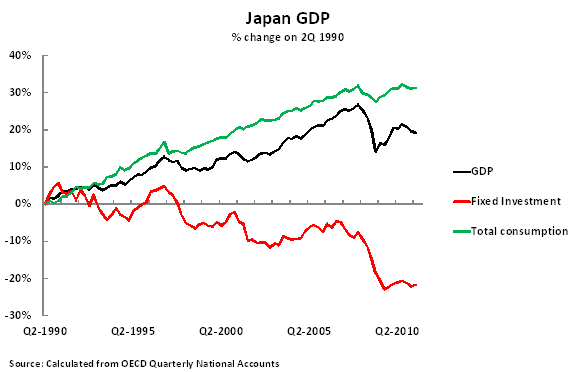Do the US, Europe or China face 'Japanization'?
- By John Ross
 0 Comment(s)
0 Comment(s) Print
Print E-mail
China.org.cn, September 1, 2011
E-mail
China.org.cn, September 1, 2011
The resignation of Naoto Kan, Japan's sixth prime minister in six years, symbolizes the country's political impasse. It is also widely understood that the root of this is economic stagnation. Japan's average yearly GDP growth since 1990 has been only 0.6 percent.
There is now discussion in the United States and Europe about whether they face "Japanization" prolonged slow growth without economic policy tools able to overcome it. The Financial Times recently noted: "Data in the U.S. continue to disappoint…thoughts are turning to late 1990s Japan where near-zero interest rates and a central bank balance sheet growing by a rate of about 50 percent a year failed to stimulate growth." The Economist ran a cover with U.S. President Barack Obama and German Chancellor Angela Merkel in Japanese dress under the headline "Turning Japanese."
This fear is ironic given that some critics recently asserted it was China that is facing "Japanization." But China's economy has been growing strongly, expanding 9.5 percent in the first half of the year. In the same period, U.S. and European GDP growth fell to Japanese-style lows with the U.S. expanding by an annualized 1 percent and the Eurozone by 0.8 percent.
But to assess the real risks of "Japanization" in the United States, Europe or China, it is necessary to understand what occurred in Japan and why the term was created.
"Japanization" described a new economic phenomenon. Economists were familiar with the business cycle with alternating growth and recession. Some cycles were mild, fluctuations of a few percent, while others most notoriously after 1929 were large and violent. But all showed economies growing or contracting. Even the post-1929 deep collapse was followed after four years by relatively rapid upswing.
Japan was something new. Its GDP did not fall drastically. Living standards did not collapse and the population's consumption continued to rise. Between 1990 and 2011, total consumption rose at an annual average of 1.1 percent. But fixed investment remorselessly kept falling by an average 1.3 percent a year. By the second quarter of 2011, Japan's investment was 22 percent below its 1990 level. Japan therefore combined rising consumption and falling investment, and as a result, underwent a prolonged relative stagnation never before seen in a developed economy






